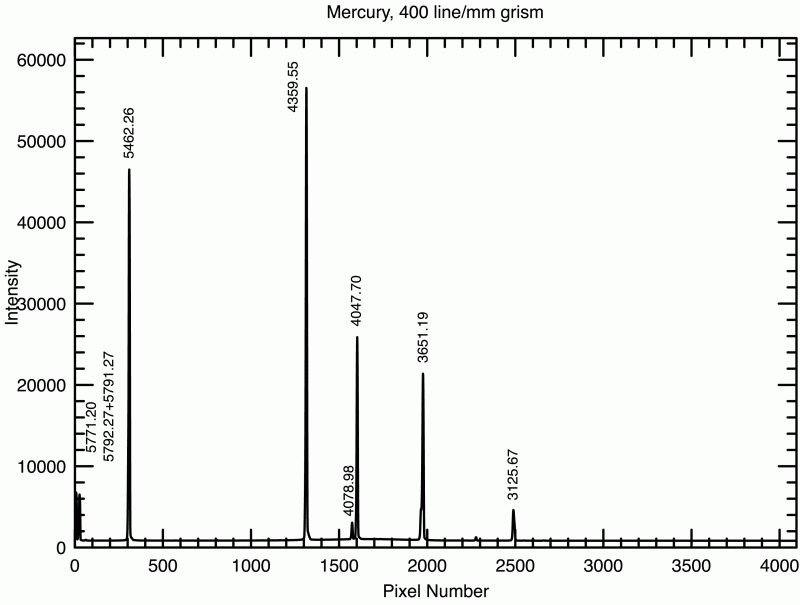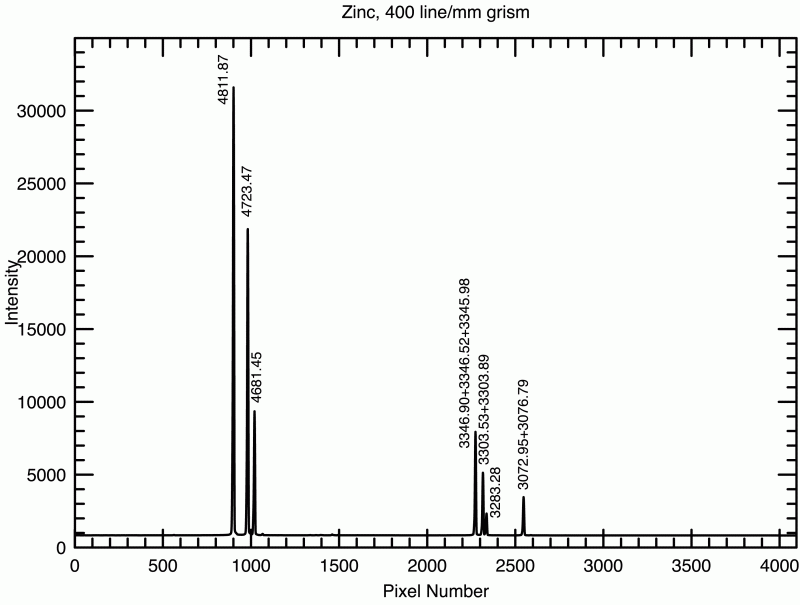LRIS is equipped with a standard set of Oriel calibration lamps which
allow wavelength calibration of both the blue and the red spectra.
The lamps light is directed back up the light path, where it reflects off
a white surface on the inside of the trapdoor
and back into the instrument.
The lamps are mounted inside the front end of LRIS adjacent to the
slitmask plane. With the only exception of the Cd and Zn, the
lamps are mounted on the offset guider assembly: their position and the quality of illumination
may change, depending on the position of the offset guider within the field. The Cd and Zn lamps
are mounted on the slitviewing guider bulkhead and their light is partly
vignetted by the guider's entrance lens. The rightmost slits in the MOS
field of view, as seen by the detectors, receive less light then to the
others.
The trapdoor must be closed when taking exposures using the lamps.
Some of the arc lamps are single lamps and the rest are pairs. The table below lists the arc lamp complement and provides plots for all of them with different resolutions. Clicking in the Range field will open a line list for the corresponding lamp. Clicking on the R field will give a plot for the corresponding lamp at the chosen resolution. The Exp. Time column indicates the typical exposure time for the corresponding resolution.
| Lamp(#) |
Range
[Å] |
line lists |
R/Plot |
Old Plots |
Comment |
| Hg (2) |
1570-7420 |
air |
vac |
300 |
300 |
Needs at least 1 minute warm up. |
| Cd (1) |
1570-7420 |
air |
vac |
300 |
|
Needs 2 minutes warm up. |
| Zn (1) |
1570-7420 |
air |
vac |
300 |
|
Needs 2 minutes warm up. |
| FeNe (1) |
3100-3850 |
air |
TBD |
1200 (1) 1200 (2) |
|
Needs 5 minutes warm up and 30 seconds exposure |
| Ar (2) |
6800-9420 |
air |
vac |
600 |
300 |
Red side lamp. |
| Ne (2) |
5700-7603 |
air |
vac |
831 |
300 |
Red side lamp. |
| Xe (2) |
7600-9500 |
air |
TBD |
900 |
None |
Red side lamp. |
| Kr (2) |
7600-9500 |
air |
TBD |
900 |
None |
Red side lamp. |
A complete IRAF compatible line list is available (lines measured in vacuum conditions).
Wavelength solutions using the line list above may have large residuals in the blue-side at resolutions of 600, 400, and 300.
Dr. Shapley & Steidel determined the blend effective wavelengths for a few lines based on the relative strengths of lines in
calibration spectra with R=1200. The blended lines list identifies blended lines at
a R=400. The blended lines are applicable to spectra with R=300 and 600. An exception is that the Hg I 3125/3131 doublet is
resolved at R=600.
ARCPLOTS is a planning tool written in IDL6.0. The tool plots a 1-D
spectrum from LRIS data as a function of selected arm (red or blue), dispersive element (any grating or grism), resolution
(150, 300, 400, 600, 831, 900 and 1200) and lamp. It allows interactive line recognition, plotting of line wavelengths,
selection of wavelength range (red side) and print to file/printer. Multiple combinations of lamps are allowed.
In order to run Arcplots, select from the desktop menu:
LRIS Utilities -> Arcplots
ARCPLOTS does not require IDL6.0 to run and may be run using the IDL Virtual Machine which is available for free from the
IDL Vritual Machine home page.
Instructions for running ARCPLOTS and the necessary
files to run the routines are publicly available.
Blue-side spectra can be wavelength-calibrated with the mercury, cadmium, and zinc lamps. These metal lamps, however,
must be allowed to warm up thoroughly before using them. Otherwise you will get a
baffling spectrum (black, from Cd lamp after just being turned on)
that will actually be red argon lines leaking into the blue side (blue spectrum overplot). If you see something similar you
need to let the lamps warm up more. Note that the strongest lines in the cadmium spectrum correspond to lines also seen in
the argon spectrum. (They are weaker, however.) The cadmium lines can also be seen, but they are much weaker than they will
be after letting the lamp warm up for a minute or, better, two.
The reason for the argon lines is that argon is often the carrier gas filling the arc tube. When one of the metal lamps
is first turned on, the argon becomes ionized first and you only see lines from it. After a minute or two these lines are
replaced by the metal lines, as the metal evaporates off the lamp filaments.
Properly warmed up lamps show spectra like the following (taken with the long slit and the 400 line/mm grism):


